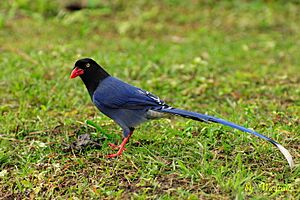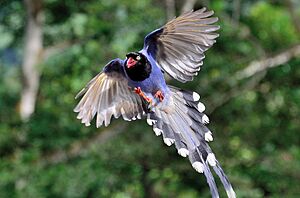Taiwan blue magpie facts for kids
Quick facts for kids Taiwan blue magpie |
|
|---|---|
 |
|
| Conservation status | |
| Scientific classification | |
| Genus: |
Urocissa
|
| Species: |
caerulea
|
The Taiwan blue magpie (Urocissa caerulea) is a beautiful bird found only in Taiwan. People also call it the Taiwan magpie or Formosan blue magpie. In some local languages, it's known as the "long-tailed mountain lady" because of its long tail. This bird is part of the crow family, which includes crows, jays, and other magpies.
Contents
About the Taiwan Blue Magpie
The Taiwan blue magpie was first studied by Robert Swinhoe and described by John Gould. Swinhoe even translated its local name, calling it the "Long-tailed Mountain-Nymph." This bird is unique because it is the only type of its kind found in Taiwan. It is related to other blue magpies, like the yellow-billed and red-billed blue magpies.
Where Taiwan Blue Magpies Live
Taiwan blue magpies live only in Taiwan. They prefer to live in thick forests with broadleaf trees. You can find them in the mountains at heights between 300 and 1,200 meters (about 1,000 to 4,000 feet) above sea level.
What Taiwan Blue Magpies Look Like
These birds are quite long, usually about 63 to 68 centimeters (25 to 27 inches) from head to tail. Their tail alone can be 34 to 42 centimeters (13 to 17 inches) long! Their wings are about 20 centimeters (8 inches) long. An adult magpie weighs around 254 to 260 grams (about 9 ounces).
Both male and female Taiwan blue magpies look very similar. Their head, neck, and chest are black. They have bright yellow eyes, and their beak and feet are red. The rest of their body is mostly a beautiful blue color. The tips of their wings and tail feathers are white. The longest feathers are in the middle of their tail. Young chicks are grayish with a short tail and grayish-blue eyes.
Taiwan Blue Magpie Behavior
Taiwan blue magpies are not very shy around people. You might see them close to homes in the mountains or in new farming areas. They like to be in groups, usually with three to twelve birds. These groups often fly in a line, one after another. People sometimes call this their "long-tailed formation."
Like other birds in the crow family, they make loud calls. Their sounds are described as a high-pitched cackling chatter, like "kyak-kyak-kyak-kyak." They also make other sounds, such as "ga-kang, ga-kang" and "kwee-eep."
What Taiwan Blue Magpies Eat
Taiwan blue magpies are scavengers and omnivores. This means they eat many different things. Their diet includes snakes, small animals like rodents, insects, and even dead animals. They also eat eggs and chicks from other birds. For plants, they enjoy fruits and seeds. Sometimes, they even eat food scraps left by humans. They are clever about food storage. They might bury leftovers on the ground and cover them with leaves to eat later. They also hide food in tree branches.
Taiwan Blue Magpie Life Cycle and Reproduction
The breeding season for Taiwan blue magpies is from March to July. They are monogamous, meaning one male and one female stay together to raise their young. The female bird sits on the eggs to keep them warm, a process called incubation. The male helps by building the nest and bringing food.
Their nests are shaped like a bowl and are built high up in tree branches using twigs. A female usually lays 3 to 8 eggs. The eggs are light green with brown spots. It takes about 17 to 19 days for the eggs to hatch. After hatching, there are usually 3 to 7 chicks in a nest. The chicks leave the nest when they are about 21 to 24 days old. A few days later, they can fly short distances. Some pairs might even have a second group of chicks in the same season.
Interestingly, older, younger birds from previous years often help raise the new chicks. They help feed the babies and protect the nest. Taiwan blue magpies are very protective of their nests. They will attack anyone or anything that comes too close until the intruder leaves.
Challenges for Taiwan Blue Magpies
Taiwan blue magpies can face some dangers. Sometimes, they are hit by cars. They can also be caught by people, though this happens less often now. Natural predators also hunt them. These include birds of prey like the crested goshawk, white-bellied sea eagle, and spot-bellied eagle owl.
Taiwan Blue Magpies and People
The Taiwan blue magpie is a special bird for some of Taiwan's native groups, like the Tsou, Thao, and Bunun peoples. In their old stories about a great flood, the Taiwan blue magpie is said to have helped people survive. It bravely carried fire from the highest mountain, Yu Shan, to the people who were stranded.
While they are special, Taiwan blue magpies have sometimes attacked people to protect their nests. In 2007, there was a vote to choose Taiwan's national bird. Many people from around the world voted, and the Taiwan blue magpie won against the Mikado pheasant. However, this vote was not officially accepted.
The Taiwan blue magpie has also inspired modern designs. In 2017, China Airlines painted a beautiful Taiwan blue magpie on one of their Airbus A350 airplanes. Also, a new jet trainer aircraft, the AIDC XAT-5 Blue Magpie, is named after this bird.
Conservation Status
The Taiwan blue magpie is currently listed as a species of "least concern" by the IUCN Red List of Threatened Species. This means their population is stable and not in immediate danger. However, because they only live in Taiwan, they are still protected by Taiwan's Wildlife Conservation Act. This law helps make sure they stay safe.
There was a concern about another type of magpie, the red-billed blue magpie, which was brought to Wuling Farm in Taiwan. In 2007, some hybrid chicks were found, meaning they had one red-billed parent and one Taiwan blue magpie parent. This worried conservationists because it could affect the unique Taiwan blue magpie. To help, the Endemic Species Research Institute of Taiwan has been working to control the red-billed magpie population. They do this by catching individual birds and moving their nests.
See also
- List of protected species in Taiwan
- List of endemic birds of Taiwan
- List of endemic species of Taiwan



